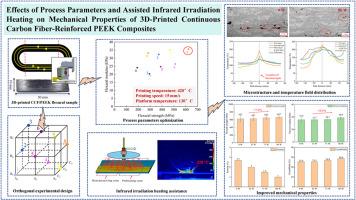通过工艺参数优化和辅助红外辐照加热提高连续碳纤维增强PEEK复合材料的力学性能
IF 7.7
2区 材料科学
Q1 MATERIALS SCIENCE, COMPOSITES
引用次数: 0
摘要
3d打印连续碳纤维增强复合材料(CCFRCs)因其高度自动化、设计灵活性和成本效益而成为制造高性能复合材料的一种有前途的方法。聚醚醚酮(PEEK)因其优异的机械性能、耐热性和化学稳定性而被广泛认为是CCFRCs理想的热塑性基体材料。然而,利用3D打印技术制造连续碳纤维增强PEEK (CCF/PEEK)复合材料仍然面临着很大的工艺障碍。复合材料的高粘度和高熔融温度导致层间结合弱,孔隙率高,严重影响打印复合材料的整体性能和质量。针对这些问题,本研究采用正交实验设计,探讨打印温度、打印速度和平台温度等工艺参数的协同效应,并对关键变量进行系统优化。此外,还设计并集成了精密红外辐射加热器,以改善层间结合并减少孔隙率。结果表明,优化的工艺参数和辅助红外加热相结合可以实现稳定和高质量的3d打印CCF/PEEK复合材料。本文章由计算机程序翻译,如有差异,请以英文原文为准。

Enhanced mechanical properties of continuous carbon fiber-reinforced PEEK composites via process parameters optimization and assisted infrared irradiation heating
The 3D-printed continuous carbon fiber-reinforced composites (CCFRCs) have emerged as a promising approach for fabricating high-performance composites due to their high degree of automation, design flexibility, and cost-effectiveness. Polyether-ether-ketone (PEEK) is widely recognized as an ideal thermoplastic matrix material for CCFRCs because of its outstanding mechanical properties, thermal resistance, and chemical stability. Nevertheless, the fabrication of continuous carbon fiber-reinforced PEEK (CCF/PEEK) composites via 3D printing is still confronted with significant processing obstacles. The high viscosity and elevated melting temperature of the composites lead to weak interlayer bonding and high porosity, which severely undermine the overall performance and quality of the printed composites. To address these issues, this study adopted an orthogonal experimental design to explore the synergistic effects of process parameters, including printing temperature, printing speed, and platform temperature, and systematically optimize critical variables. Furthermore, a delicate infrared irradiation (IR) heater was designed and incorporated to improve interlayer bonding and reduce porosity. The results demonstrate that the combination of optimized process parameters and assisted IR heating enables stable and high-quality 3D-printed CCF/PEEK composites.
求助全文
通过发布文献求助,成功后即可免费获取论文全文。
去求助
来源期刊

Composites Communications
Materials Science-Ceramics and Composites
CiteScore
12.10
自引率
10.00%
发文量
340
审稿时长
36 days
期刊介绍:
Composites Communications (Compos. Commun.) is a peer-reviewed journal publishing short communications and letters on the latest advances in composites science and technology. With a rapid review and publication process, its goal is to disseminate new knowledge promptly within the composites community. The journal welcomes manuscripts presenting creative concepts and new findings in design, state-of-the-art approaches in processing, synthesis, characterization, and mechanics modeling. In addition to traditional fiber-/particulate-reinforced engineering composites, it encourages submissions on composites with exceptional physical, mechanical, and fracture properties, as well as those with unique functions and significant application potential. This includes biomimetic and bio-inspired composites for biomedical applications, functional nano-composites for thermal management and energy applications, and composites designed for extreme service environments.
 求助内容:
求助内容: 应助结果提醒方式:
应助结果提醒方式:


